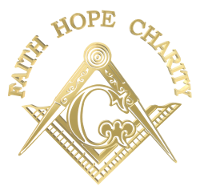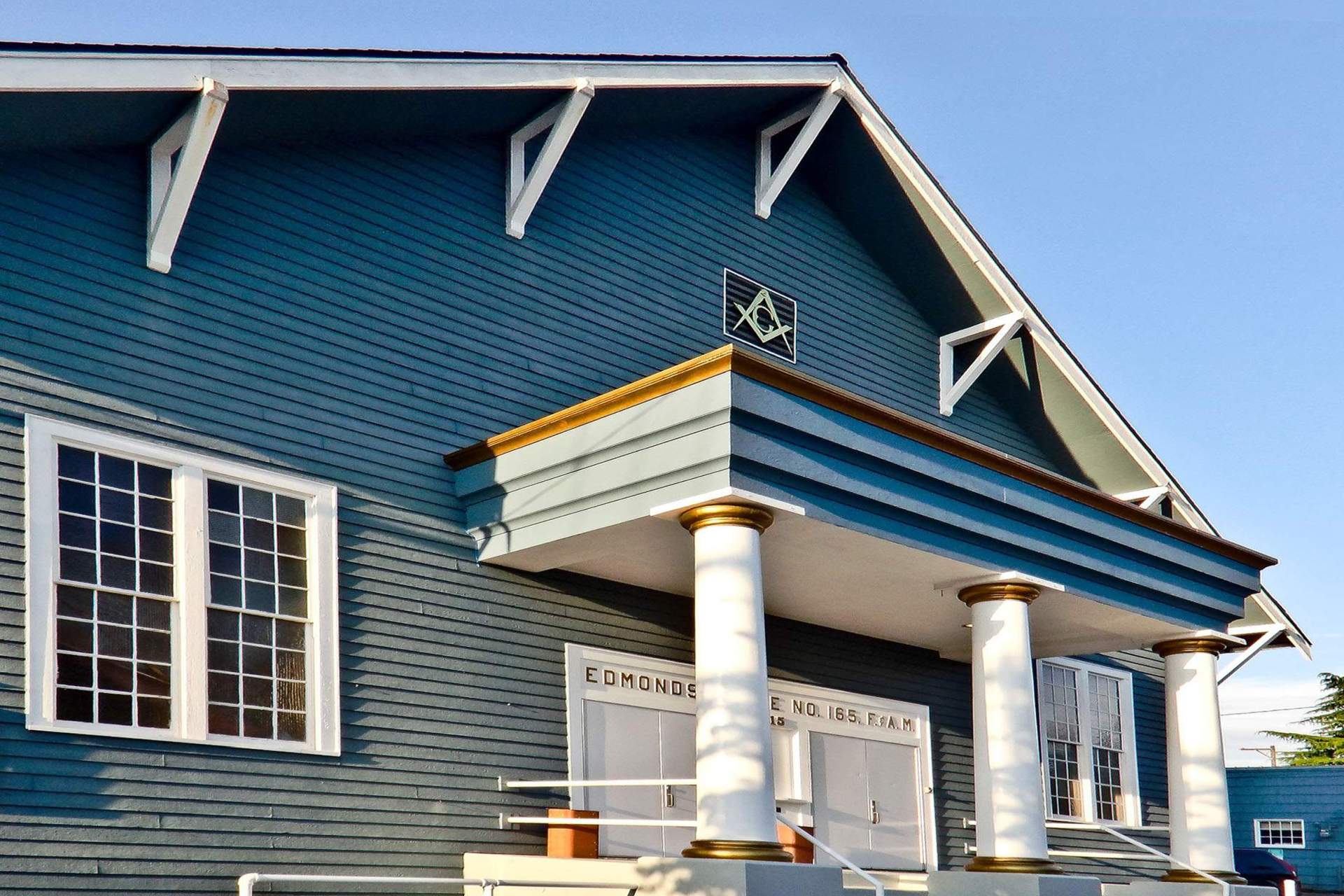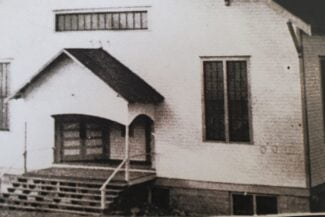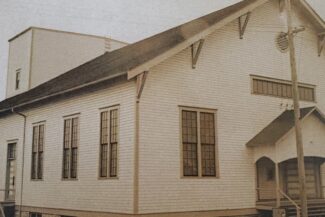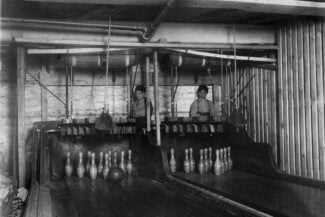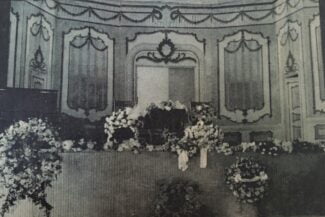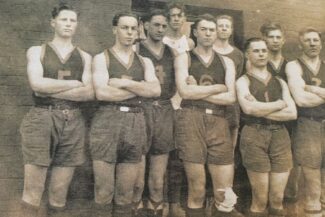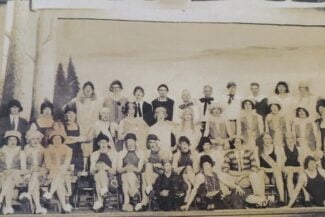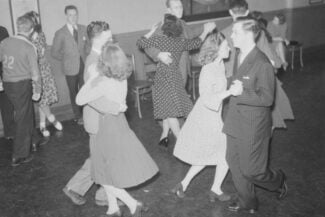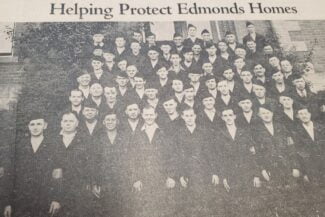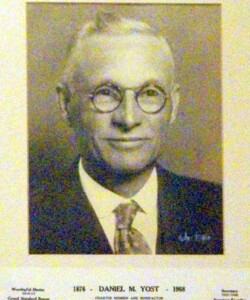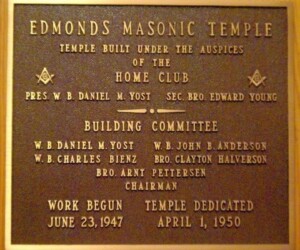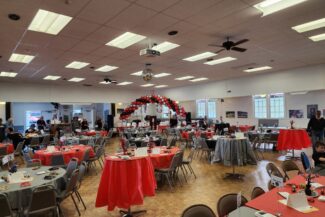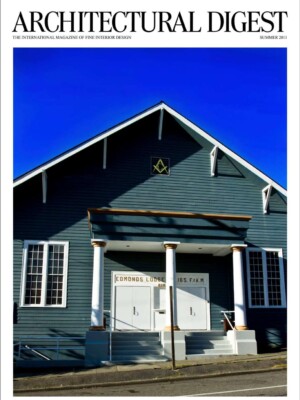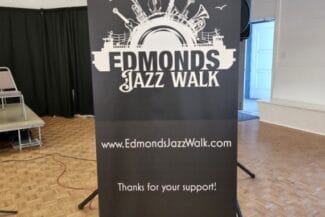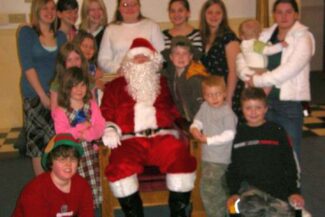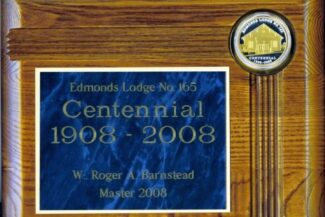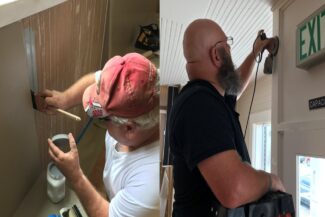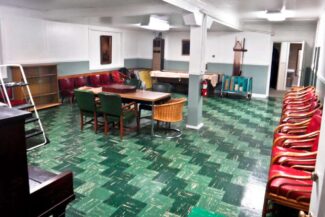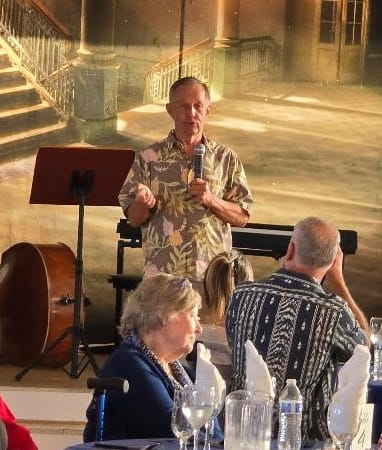The Old Edmonds Opera House
Byron Wilkes, Steve Pennington, Tom Stone, Kelly Humann, & Roger Barnstead.
The building includes essentially a ‘Who’s Who’ of Edmonds history. George Brackett, several members of the Yost family, Ray V. Cloud, former mayors, business leaders, decorated military members, and a host of interesting characters have ties to this wonderful building.
The Old Edmonds Opera House, later a skating rink, now home to the Edmonds Masonic Lodge, stands majestically in the center of the block of Dayton Street between 5th and 6th Avenues. The building serves as a symbol of the town’s history and of its present-day significance.
The Old Edmonds Opera House Through Time
Based on the My Edmonds News Articles by Byron Wilkes
The Visionaries & Edmonds Athletic Club
A December 24, 1908 article in the Edmonds Tribune outlined the fact that an Edmonds Athletic Club had been organized during the week. The paraphrased article stated: “Invitations having been sent to about seventy-five of the young men and women of this city to gather to organize an athletic club, sixty five responded and after choosing Mayor James Brady as temporary chairman, proceeded to transact business.
After canvassing the attendees, fifty seven names made up the original list of members. An initiation fee of $2.50 per member plus monthly dues of fifty cents were established.
A committee headed by O.K. Mowat and Edgar Smith were instructed to draft a constitution and by-laws. A monthly lease at the cost of $20.00 was also agreed upon for the Edmonds Pavilion.
A Permanent Facility
By the summer of 1909, the membership and needs of the Athletic Club had outgrown what any building or establishment could provide. The members began to explore options whereby they’d have a facility where they could store their equipment and have access to a permanent athletic facility at all times.
After discussions with A.M. Yost it was announced that he was willing to help. A September 30, article entitled “Gymnasium Building Assured” in the Edmonds Tribune stated that Yost had agreed to build an extension onto the Socialist Hall building that he owned between 5th and 6th Avenues on Dayton Street. Mr. Yost erected a Large Building to be used as Opera House and Home of Edmonds Athletic Club, where superintend its construction and remained the owner of the new building. His intention was to build a substantial structure and one that will be a credit to Edmonds and accommodate her citizens for many years to come. He will arrange its construction so as to invite all manner of entertainments and shows to make use of it. A large stage and scenery loft will be provided with dressing rooms on each side of the stage. The building will have a covered floor of 60 X 80 feet and the roof will be trussed and supported in such a manner as to leave the entire floor space clear from any obstruction whatsoever. He moved the old socialist hall to the east of its former location and will be added to and converted into a dwelling.
Construction & Dedication. 1909
A large crew began work the following week under the supervision of A. M. Yost. The work proceeded rapidly but not without incidents. As the work proceeded newspaper articles documented the fact that A.M. Yost had purchased a furnace that would comfortably heat the entire building at the cost of $1,000. Additionally chairs, furniture, scenery and other necessary equipment were purchased at the cost of $9,000.
As the building was nearing completion, the Edmonds Athletic Club moved its equipment into the exercise rooms on the sides of the main floor, establishing athletic areas inclusive of mats, Indian clubs, weights, a heavy punching bag, boxing gloves and other athletic gear.
The new facilities were dedicated on Christmas Eve 1909 in front of a large audience. The celebration included the first basketball game to be played in the new gymnasium. The Edmonds squad beat the Everett Y.M.C.A team that night.
Exceptional Athletics. 1911-1912
In 1911 both the Edmonds Athletic Club basketball teams excelled. The women’s team won almost all of their games. The team was led by Edmonds’ legendary athlete and educator, Frances Anderson. Many of the games were played in the new Edmonds gymnasium. The Seattle Times described the facilities as one of the best basketball facilities in the State, and stayed that the games were played in front of packed houses.
A Bowling Alley. 1911
In 1911, A.M. Yost added two bowling lanes to the building in hopes of increasing both the number of Athletic Club members and the club’s revenue. Automatic pin settlers did not exist then. The pins had to be reset by hand. The men and boys who cleared away the downed pins and reset them were called “pin settlers”.
Music, Smokers, & Other Entertainment, 1910’s
Through 1911 and up to the middle of 1912 the Edmonds Athletic Club and its management ran the day to day operations of the athletic club and also hosted dances, plays and other musical events in the large multi-purpose space. Saturdays often had a number of different events running from the early afternoon into the evening. A typical Saturday included an hour long recital from a touring musical group, followed by a basketball game, which in turn was followed by a dance.
At the start of 1912, the athletic club was also hosting “smokers”, boxing events between local pugilists. Not all of the events went off as originally advertised or planned. The Edmonds Tribune recounted Saturday dances, weddings, a Halloween Masquerade ball, and numerous societal club meetings at the Opera House.
The End Of An Era. The Death of Alan M. Yost. 1915
Tragically in August of 1915, A.M. Yost suffered a massive stroke and died in Leavenworth, while on a motor trip with his family. His body was transported back to Edmonds and his memorial service was held at the Opera House. The Edmonds Tribune reported that numbers of well wishers and community members attended to the memorial service and the funeral.
After A.M. Yost’s passing the family continued to manage the opera house through the end of the decade. The venue was the site of a large number of weddings, funerals, social and business events and dances.
The 1920’s.
The decade began with the Edmonds men’s basketball team winning multiple tournaments and being declared the best basketball team in the state. Unfortunately the overall appeal of the athletic club waned during the middle of the decade and the club disbanded in 1926.
Conversely in the 1920s The Edmonds Civil Club became a large client of the Opera House, leasing it to arrange and host a number of indoor and outdoor activities to promote the “welfare of the community”.
Additionally the Chautauqua movement emerged in the 1920s. The Chautauqua movement was an organized series of educational and entertaining presentations. Speakers included teachers, religious preachers, actors, industrial figures, musicians, and specialists in a wide variety of fields. The Edmonds Opera House was the venue chosen for the presentations throughout the early part of the decade.
At the end of the decade the Opera House became the home of the Edmond’s Legion Post #66 annual variety shows and was the chosen venue for the Edmonds Floretum Club, the American Legion and the Edmonds Parent Teacher Association’s meetings and sponsored events.
Great Depression Era. The 1930’s
During the depression era similar to previous decades the Opera House continued to be a chosen place for business and social gatherings. The most notable addition was weekend dances that were spurred on by new dances and the popularity of Fred Astaire and Ginger Roger films.
At the beginning of 1931, Bob Wheeler leased the Opera House for Friday and Saturday evening dances. Wheeler’s dance offerings included the swing, rumba, salsa, the lindy hop and the jitterbug. By September of 1931, Wheeler’s dances were receiving serious protests from members of the community. Complaints ranged from the loud music coming from the Opera House to the skimpy clothes some of the women were wearing, to the amount of intoxication that appeared to be affecting the participants.
The city’s officials eventually asked Wheeler to tone down the music and to curtail some of the consumption of alcohol, but the officials also realized that citizens needed to an avenue to relieve some of the stress they were experiencing on a day to day basis.
Dances including a 1936 Dance Marathon continued despite the objections of some citizens.
World War II Era. The 1940’s
Immediately after the attack on Pearl Harbor on December 7th, 1941, every city was required to organize a home guard reserve unit. Edmonds’ Company converted the Opera House into its head quarters and ran its drill operations out of it for the next five years. The Edmonds Guard roster included 137 guardsmen who served throughout the war. Their headquarters were located in the Opera House until they disbanded in 1946.
Building Sold To Edmonds Masonic Lodge #165. 1944
In 1944, while World War II was still raging the Yost family sold the Opera House to Edmonds Masonic Lodge #165. Interestingly Masonic Lodge #165 was founded in 1908, the same year as the original Edmonds Athletic Club.
The first meeting of the lodge in its new home was held on December 12, 1946. During the next two and a half years extensive improvements were made to the building, largely by volunteer labor and contributions of the members. A new wing was added for the lodge room in 1947, the basement was made into a large attractive dining room, a modern kitchen was installed, and permanent siding was added to the outside of the building.
The remodeled Opera House was dedicated as the new Masonic Lodge on April 1, 1950. Over the last 74 years the lodge has continued to support the Edmonds community in a wide variety of ways. They have continued to provide a valuable venue for our the community’s activities plus engaging in a number of outreach programs.
Uses & Community Involvement. Late 20th Century
Events hosted include the Edmonds Friday night Edmonds High School canteen dances, weddings, memorial services, square dances and dance groups, holiday events, pipe bands, bazaars and craft shows and private parties.
The Old Opera House has been featured in many places including the Architectural Digest.
Events Since 2008.
The lodge has also hosted the Edmonds Jazz Connection, the Edmonds Jazz Walk, Santa pictures at the Edmonds Christmas Lighting event and several Chamber events including a comedy night event.
Old Opera House Centennial. 2008
The centennial for the Old Opera House was celebrated in grand style.
Maintenance & Annual Old Opera Fund Raiser
As with all old buildings, we repair damage as it happens and aspire to a revitalized building as we can. We had a sewer backup in 2023 damaging bathroom floors, and ceilings, walls and carpets in the rooms below and resulting in significant repair costs.
The inaugural fundraiser allowed us to refinish our Ballroom floor. There are a number of internal and external items on our list.
About Byron Wilkes
An Edmonds historian and researcher published in My Edmonds News and others.
Thank You Byron!

